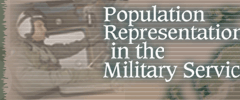


 |
 |
 |
|
Representation Within Occupations Each Service classifies enlisted occupations using DoD occupational codes. At the most general level, there are 10 one-digit categories as shown in Table 3.8. Occupational codes get more specific, with two- and three-digit codes. The number of codes increases with each level of specificity. Infantry, gun crews, and seamanship includes more than infantry. Enlisted personnel serving on gun crews and those serving in some ship-based occupations are included. Specific specialties include infantryman, special forces, tank crewman, gunner’s mate, in-flight refueling, and quartermaster. Electronic equipment repairers consists of those jobs requiring knowledge of electronics to maintain and repair electronic equipment. Jobs included are electronics technician, radio repairer, communication and navigation systems specialist, air traffic control radar technician, missile systems maintenance, and computer technician. Communications and intelligence specialists includes personnel who operate electronic equipment, such as radios, and others specializing in communication or intelligence. For example, radioman, air traffic controller, linguist, and intelligence/counter-intelligence specialist all fall into this category. Medical and dental specialists are health care workers. Types of occupations within this category include medical service specialist, aeromedical specialist, pharmacy specialist, and dental laboratory specialist. Other allied specialists includes a variety of occupations, not captured by the other codes. Examples of specific jobs are photojournalist, cartographer, weather specialist, musician, and disaster preparedness specialist. Functional support and administration encompasses positions related to administrative functions of the Services. Personnelman, recruiter, information management specialist, computer programmer, accounting specialist, traffic manager, and public affairs specialist are jobs included in this code. Like electronic equipment repairers, electrical/mechanical equipment repairers are involved in maintenance and repair of Service-specific equipment. Compared to electronic equipment repairers, these jobs deal with more mechanical, less electronically-sophisticated maintenance and repair. Types of jobs in the electrical/mechanical equipment repair area are aviation safety specialist, aircraft mechanic, vehicle mechanic, nuclear weapons specialist, and electrician’s mate. Craftsmen includes the skilled blue collar trades. Types of positions include metal worker, crane operator, plumber, and electrician. Service and supply handlers include food service specialists, vehicle operators, military police, parachute riggers, and morale, welfare, and recreation specialists. Non-occupational personnel are those who have not completed training for an occupation or who are unable to serve in the position for which they have been trained. Patients, prisoners, students, and recruits are included in this category. The percentages of enlisted personnel by occupational area in FY 2002 are shown in Table 3.8. No shifts in the occupational distribution of the force occurred this year. The majority of enlisted members serve in electrical/mechanical equipment repair (21 percent), infantry, gun crews, and seamanship (17 percent), or functional support and administration (16 percent). These occupational areas have been predominant in the Armed Services at least since FY 1976, the earliest year for which reliable data are available.[Footnote 11]
The assignment of enlisted personnel to military occupations depends on eligibility (determined by ASVAB scores and sometimes other tests or requirements), individual preference, and the availability of openings. As part of the occupational classification process, the military uses aptitude composites made up of ASVAB test scores related to occupations. The composites vary by Service, and are developed empirically to predict the probability of training success. Men tend to score higher than women on the ASVAB tests in the mechanical and electronics composites, while women tend to do better on administrative measures. On average, Whites have higher test scores than Hispanics and “Other” minorities, who in turn have higher scores than Blacks. Within each demographic group, there is wide variation in ASVAB -test scores, and most recruits qualify for a number of occupations. The recruits' preferences and the availability of openings for which they are qualified determine the occupations to which individuals are assigned. Women and occupational assignments. The major shift that has occurred in assignment patterns for women in the last two decades has been to increase their presence in "non-traditional" jobs. In the early 1970s only about 12 percent of enlisted women served in areas considered non-traditional (gun crews, communications, craftsmen, etc.). In FY 2002, however, 45 percent of all enlisted women were in these occupations. Women are ineligible for infantry and other positions in which the primary mission is to physically engage the enemy.[Footnote 13] However, women can serve on aircraft and ships engaged in combat. In FY 2002, 5 percent of enlisted women were in occupational code 0 (infantry, gun crews, and seamanship specialists). The percentage of enlisted men in these occupations was nearly four times that of enlisted women because of the direct ground combat exclusion policy for women. The occupational differences by gender are illustrated in Table 3.8. In FY 2002, almost half of enlisted women were in functional support and administration or health care occupations (33 percent in administration and 15 percent in healthcare). In contrast, only 18 percent of enlisted men were in these occupations. This shows that although the percentages of women in the technical and craftsmen occupations are greater now than when women first joined the military, men continue to account for the preponderance of enlisted personnel in these areas. Minorities and occupational assignments. In FY 2002, the proportions of Black, White, and Hispanic Servicemembers were similar in three of the nine occupational areas—medical and dental specialists, other allied specialists, and craftsmen (Table 3.9). In electronic equipment repair, where the proportions of Blacks, Hispanics, and “Others” were very similar, the proportion of Whites was higher. The proportions of Hispanics, “Others,” and Whites were approximately the same in service and supply handlers, and were lower than Blacks. In electrical/mechanical equipment repair, Whites, Hispanics, and “Others” were similar and were higher than Blacks. Blacks were more heavily represented in the functional support and administration area and, to a lesser extent, the service and supply area.
[Footnote 11] Gribben, M., Trends in Distribution of Military Personnel Across Occupational Categories, paper presented to the Committee on the Youth Population and Military Recruitment of the National Academy of Sciences, Washington, DC, May 2001. [back to paragraph] [Footnote 12] Levy, D.G., Thie, H.J., Robbert, A.A., Naftel, S., Cannon, C., Ehrenberg, R., and Gershwin, M., Characterizing the Future Defense Workforce (Santa Monica, CA: RAND Corporation, 2001). [back to paragraph] [Footnote 13] Memorandum from Les Aspin, Secretary of Defense, Subject: Direct Ground Combat Definition and Assignment Rule, January 13, 1994. [back to paragraph] |
||||||||||||||||||||||||||||||||||||||||||||||||||||||||||||||||||||||||||||||||||||||||||||||||||||||||||||||||||||||||||||||||||||||||||||||||||||||||||
|
|